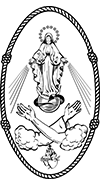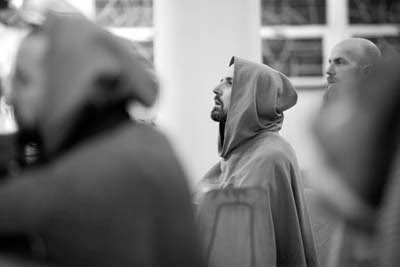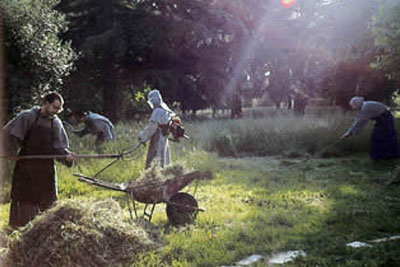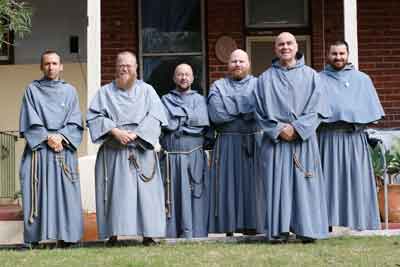Beginnings of Our Institute
Our Beginnings
The Franciscans of the Immaculate were founded by the two Franciscan friars, Fr. Stefano Maria Manelli and Fr. Gabriel Maria Pellettieri. Together they outlined a form of life for the friars, sisters and the laity after the example of St. Maximilian Mary Kolbe, giving the fullest expression to the Marian dimension of St. Francis’ ideal and Rule. The Franciscans of the Immaculate was established by Pope John Paul II in 1990 as a diocesan institute. The Institute was erected as a pontifical institute of religious life by His Holiness John Paul II in January 1, 1998, Solemnity of the Mother of God.
The religious community begun at Casa Mariana (Frigento, Italy), along the lines and in accordance with the counsels of St. Maximilian, was erected by His Holiness Pope John Paul II as a religious institute of diocesan rite in 1990. On that occasion the Holy Father explained that this was for the preservation and propagation of the life and mission of St. Maximilian Kolbe in the Roman Catholic Church.
This new religious institute is known as the Franciscan Friars of the Immaculate. (There is also an institute of women, living the same charism, known as the Franciscan Sisters of the Immaculate) The Franciscan Friars of the Immaculate began with about 30 friars and one house in 1990 have already grown to over 200 friars in 14 houses on 5 continents. Three of these friars came to America in the winter of 1991. Today the community in the USA has grown to 29. Fourteen of these new vocations are presently studying for the priesthood. Their studies are conducted faithfully according to the mind of the Sacred Magisterium of the Church so that they may be holy and God-fearing sons of Holy Mother Church.
The Marian Spirit of St. Francis of Assisi
St. Francis of Assisi (1182-1226 A. D.), the poverello and troubadour of Christ Crucified, was and is one of the greatest devotees of the Mother of God in the history of the Church. Indeed his entire life was encompassed in this endeavor: “To live the life and poverty of Our Most High Lord Jesus Christ and His Holy Mother, and to persevere in this to the end.” It was with St. Francis that devotion to the Immaculate Virgin began to grow with new vigor in the Church. He sung Her praises in his Salutation to the Blessed Virgin Mary: “Hail O Lady, Holy Queen, Holy Mother of God, Virgin made church…” He extolled Her incomparable union with the Most Holy Trinity in his antiphon for the Office of the Passion: “Holy Virgin Mary, among women there is no one like You born into the world. You are the Daughter and the Handmaid of the Most High King and Father of Heaven, You are the Mother of Our Most Holy Lord Jesus Christ, Your are the Spouse of the Holy Spirit, …” Not only did St. Francis sing Her praises and invoke Her Maternal intercession every day, but he went so far as to confess his sins and failings to Her, so as to obtain more assuredly the forgiveness and pardon of Her Divine Son. St. Francis exhorted his friars to have always a fond and living devotion to the Mother of Christ. Indeed it was the example of St. Francis’ love and devotion to Her that began two great movements in the church that have characterized Marian devotion among Roman Catholics ever since. These were an unshakable faith in the Immaculate Conception and the ardent and devoted service of Her known as total consecration.
Spurred on by the example of their Seraphic Father, the Franciscans promoted and popularized devotion to the Mother of God throughout the Church and world during the last 800 years. Their work along these lines has already born fruit: Venerable Pope Pius IX, declared the fact of the Immaculate Conception of the Blessed Virgin Mary, a dogma of the faith in 1854. Likewise, Venerable Pope Pius XII declared the Assumption of the Blessed Virgin Mary to be held unshakably by all Catholics as a dogma of the faith in 1950.
St. Maximilian Mary Kolbe: A most faithful follower of St. Francis
St. Maximilian Mary Kolbe (1894-1941 A. D.), a member of the Order of Friars Minor Conventual, is one of the newest saints in the Roman Catholic Church. He was beatified in 1973 by Venerable Pope Paul VI and canonized in 1982. Pope John Paul II took that occasion to explain why he had chose to canonize St. Maximilian as a martyr: for in sacrificing his life at Auschwitz to save the life of a father of a family from certain death in the starvation bunker, St. Maximilian Maria Kolbe attained to a particular and exceedingly close conformity to Jesus Christ, who while we were yet sinners, laid down His own life to redeem us from the everlasting damnation of Hell.
St. Maximilian was born in Poland and studied for the priesthood as a Conventual Franciscan in Rome, Italy. While in Rome, he was inspired to found the Militia of the Immaculate, a public association of the faithful for the conversion and sanctification of all souls by means of devotion to and service of the Blessed Virgin Mary. Upon returning to Poland after WWI, St. Maximilian promoted this movement among the friars of his own religious institute as well as among the diocesan clergy and laity. In 1923, with the financial assistance of an American priest, he began a monthly magazine for the members of the Militia known as the Knight of the Immaculate.
St. Maximilian’s own devotion to the Blessed Virgin, as Mediatrix of All Grace, overflowed upon all he met. By 1928 He obtained permission of his superiors to found a new friary, entirely devoted to Her service. This was and is known as Niepokalanow. It lies about 60 miles outside of Warsaw, Poland. In this friary St. Maximilian anticipated by divine grace the authentic reforms of the Second Council of the Vatican as they regard religious life. There the marian spirit of St. Francis of Assisi was lived once again by all the friars. They bound themselves to Her by vows of poverty, chastity, obedience, and total consecration. They prayed, worked, and lived together for the conversion and sanctification of all souls throughout the world, in the quickest, surest, easiest manner, that is, by introducing them to the Blessed Virgin Mary according to the authentic teachings of the Roman Catholic Church.
By 1939 Niepokalanow had almost 1,000 friars, and published several million copies of newspapers and magazines, books, periodicals, pamphlets to promote the knowledge and love of the Blessed Virgin. The Militia of the Immaculate had grown to over 1,000,000 members in nearly all the nations of the glob. During the Second World War, St. Maximilian was imprisoned by the Nazi’s and sent to Auschwitz Concentration Camp, where he died the death of a martyr of charity.





